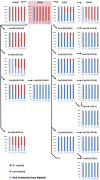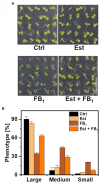Sphingolipid Long-Chain Base Phosphate Degradation Can Be a Rate-Limiting Step in Long-Chain Base Homeostasis
- PMID: 35783987
- PMCID: PMC9240600
- DOI: 10.3389/fpls.2022.911073
Sphingolipid Long-Chain Base Phosphate Degradation Can Be a Rate-Limiting Step in Long-Chain Base Homeostasis
Abstract
Sphingolipid long-chain bases (LCBs) are building blocks for membrane-localized sphingolipids, and are involved in signal transduction pathways in plants. Elevated LCB levels are associated with the induction of programmed cell death and pathogen-derived toxin-induced cell death. Therefore, levels of free LCBs can determine survival of plant cells. To elucidate the contribution of metabolic pathways regulating high LCB levels, we applied the deuterium-labeled LCB D-erythro-sphinganine-d7 (D7-d18:0), the first LCB in sphingolipid biosynthesis, to Arabidopsis leaves and quantified labeled LCBs, LCB phosphates (LCB-Ps), and 14 abundant ceramide (Cer) species over time. We show that LCB D7-d18:0 is rapidly converted into the LCBs d18:0P, t18:0, and t18:0P. Deuterium-labeled ceramides were less abundant, but increased over time, with the highest levels detected for Cer(d18:0/16:0), Cer(d18:0/24:0), Cer(t18:0/16:0), and Cer(t18:0/22:0). A more than 50-fold increase of LCB-P levels after leaf incubation in LCB D7-d18:0 indicated that degradation of LCBs via LCB-Ps is important, and we hypothesized that LCB-P degradation could be a rate-limiting step to reduce high levels of LCBs. To functionally test this hypothesis, we constructed a transgenic line with dihydrosphingosine-1-phosphate lyase 1 (DPL1) under control of an inducible promotor. Higher expression of DPL1 significantly reduced elevated LCB-P and LCB levels induced by Fumonisin B1, and rendered plants more resistant against this fungal toxin. Taken together, we provide quantitative data on the contribution of major enzymatic pathways to reduce high LCB levels, which can trigger cell death. Specifically, we provide functional evidence that DPL1 can be a rate-limiting step in regulating high LCB levels.
Keywords: LC–MS/MS; cell death; dihydrosphingosine-1-phosphate lyase; long-chain base; metabolic flux analysis; plant sphingolipid metabolism; sphingolipid.
Copyright © 2022 Lambour, Glenz, Forner, Krischke, Mueller, Fekete and Waller.
Conflict of interest statement
The authors declare that the research was conducted in the absence of any commercial or financial relationships that could be construed as a potential conflict of interest.
Figures





Similar articles
-
Synthesis and degradation of long-chain base phosphates affect fumonisin B1-induced cell death in Arabidopsis thaliana.J Plant Res. 2017 May;130(3):571-585. doi: 10.1007/s10265-017-0923-7. Epub 2017 Mar 16. J Plant Res. 2017. PMID: 28303405
-
Sphingolipid-Induced Programmed Cell Death is a Salicylic Acid and EDS1-Dependent Phenotype in Arabidopsis Fatty Acid Hydroxylase (Fah1, Fah2) and Ceramide Synthase (Loh2) Triple Mutants.Plant Cell Physiol. 2022 Mar 11;63(3):317-325. doi: 10.1093/pcp/pcab174. Plant Cell Physiol. 2022. PMID: 34910213 Free PMC article.
-
Elevated Levels of Phosphorylated Sphingobases Do Not Antagonize Sphingobase- or Fumonisin B1-Induced Plant Cell Death.Plant Cell Physiol. 2019 May 1;60(5):1109-1119. doi: 10.1093/pcp/pcz033. Plant Cell Physiol. 2019. PMID: 30796453
-
Sphingolipid homeostasis: How do cells know when enough is enough? Implications for plant pathogen responses.Plant Physiol. 2024 Dec 23;197(1):kiae460. doi: 10.1093/plphys/kiae460. Plant Physiol. 2024. PMID: 39222369 Review.
-
Metabolism and biological functions of two phosphorylated sphingolipids, sphingosine 1-phosphate and ceramide 1-phosphate.Prog Lipid Res. 2007 Mar;46(2):126-44. doi: 10.1016/j.plipres.2007.03.001. Epub 2007 Mar 14. Prog Lipid Res. 2007. PMID: 17449104 Review.
Cited by
-
Deciphering sphingolipid biosynthesis dynamics in Arabidopsis thaliana cell cultures: Quantitative analysis amid data variability.iScience. 2024 Aug 5;27(9):110675. doi: 10.1016/j.isci.2024.110675. eCollection 2024 Sep 20. iScience. 2024. PMID: 39297170 Free PMC article.
References
-
- Alden K. P., Dhondt-Cordelier S., McDonald K. L., Reape T. J., Ng C. K. Y., McCabe P. F., et al. . (2011). Sphingolipid long chain base phosphates can regulate apoptotic-like programmed cell death in plants. Biochem. Biophys. Res. Commun. 410, 574–580. doi: 10.1016/j.bbrc.2011.06.028, PMID: - DOI - PubMed
-
- Chen M., Cahoon E., Saucedo-García M., Plasencia J., Gavilanes-Ruiz M. (2009). “Plant Sphingolipids: Structure, Synthesis and Function,” in Lipids in Photosynthesis. Advances in Photosynthesis and Respiration. ed. Wada M. N. H. (Dordrecht: Springer; ), 77–115.
LinkOut - more resources
Full Text Sources
Molecular Biology Databases

